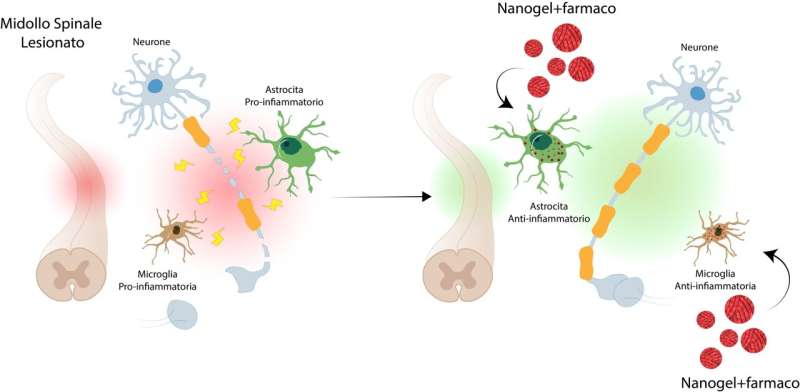This article has been reviewed according to Science X's editorial process and policies. Editors have highlighted the following attributes while ensuring the content's credibility:
fact-checked
peer-reviewed publication
trusted source
proofread
Nanomedicine paves the way for new treatments for spinal cord injury

In a study published in Advanced Materials, researchers have demonstrated that an innovative nano-vector (nanogel), which they developed, is able to deliver anti-inflammatory drugs in a targeted manner into glial cells actively involved in the evolution of spinal cord injury, a condition that leads to paraplegia or quadriplegia.
Treatments currently available to modulate the inflammatory response mediated by the component that controls the brain's internal environment after acute spinal cord injury showed limited efficacy. This is also due to the lack of a therapeutic approach that can selectively act on microglial and astrocytic cells.
The nanovectors developed by Politecnico di Milano, called nanogels, consist of polymers that can bind to specific target molecules. In this case, the nanogels were designed to bind to glial cells, which are crucial in the inflammatory response following acute spinal cord injury. The collaboration between Istituto di Ricerche Farmacologiche Mario Negri IRCCS and Politecnico di Milano showed that nanogels, loaded with a drug with anti-inflammatory action (rolipram), were able to convert glial cells from a damaging to a protective state, actively contributing to the recovery of injured tissue.
Nanogels were shown to have a selective effect on glial cells, releasing the drug in a targeted manner, maximizing its effect, and reducing possible side effects.
"The key to the research was understanding the functional groups that can selectively target nanogels within specific cell populations," explains Filippo Rossi, professor at the Department of Chemistry, Materials and Chemical Engineering "Giulio Natta" at Politecnico di Milano. "This makes it possible to optimize drug treatments by reducing unwanted effects."
"The results of the study show that nano gels reduced inflammation and improved recovery capacity in animal models with spinal cord injury, partially restoring motor function. These results open the way to new therapeutic possibilities for myelinolysis patients," says Pietro Veglianese, Head of the Acute Spinal Trauma and Regeneration Unit, Department of Neuroscience at Istituto Mario Negri.
"Moreover, this approach may also be beneficial for treating neurodegenerative diseases such as Alzheimer's, in which inflammation and glial cells play a significant role."
More information: Valeria Veneruso et al, Synergistic Pharmacological Therapy to Modulate Glial Cells in Spinal Cord Injury, Advanced Materials (2023). DOI: 10.1002/adma.202307747
Journal information: Advanced Materials
Provided by Polytechnic University of Milan



















